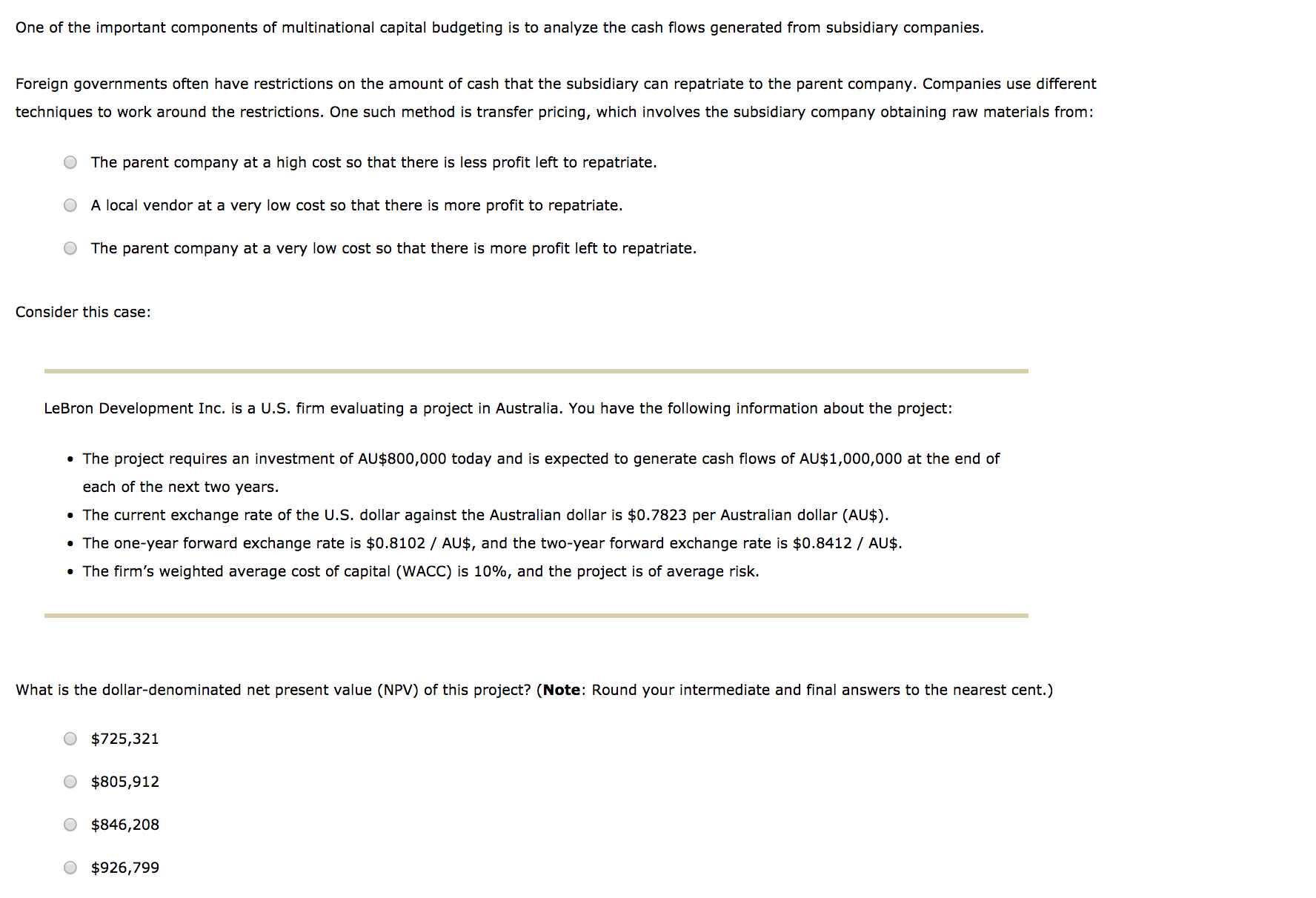One of the important components of multinational capital budgeting is to analyze the cash flows generated from subsidiary companies. Foreign governments often have restrictions on the amount of cash that the subsidiary can repatriate to the parent company. Companies use different techniques to work around the restrictions. One such method is transfer pricing, which involves the subsidiary company obtaining raw materials from O The parent company at a high cost so that there is less profit left to repatriate. A local vendor at a very low cost so that there is more profit to repatriate. O The parent company at a very low cost so that there is more profit left to repatriate. Consider this case: LeBron Development Inc. is a U.S. firm evaluating a project in Australia. You have the following information about the project The project requires an investment of AU$800,000 today and is expected to generate cash flows of AU$1,000,000 at the end of each of the next two years. The current exchange rate of the U.S. dollar against the Australian dollar is $0.7823 per Australian dollar (AU$) The one-year forward exchange rate is $0.8102 / AU$, and the two-year forward exchange rate is $0.8412 / AU$. . The firm's weighted average cost of capital (WACC) is 10%, and the project is of average risk. What is the dollar-denominated net present value (NPV) of this project? (Note: Round your intermediate and final answers to the nearest cent.) $725,321 $805,912 O$846,208 $926,799
One of the important components of multinational capital budgeting is to analyze the cash flows generated from subsidiary companies. Foreign governments often have restrictions on the amount of cash that the subsidiary can repatriate to the parent company. Companies use different techniques to work around the restrictions. One such method is transfer pricing, which involves the subsidiary company obtaining raw materials from O The parent company at a high cost so that there is less profit left to repatriate. A local vendor at a very low cost so that there is more profit to repatriate. O The parent company at a very low cost so that there is more profit left to repatriate. Consider this case: LeBron Development Inc. is a U.S. firm evaluating a project in Australia. You have the following information about the project The project requires an investment of AU$800,000 today and is expected to generate cash flows of AU$1,000,000 at the end of each of the next two years. The current exchange rate of the U.S. dollar against the Australian dollar is $0.7823 per Australian dollar (AU$) The one-year forward exchange rate is $0.8102 / AU$, and the two-year forward exchange rate is $0.8412 / AU$. . The firm's weighted average cost of capital (WACC) is 10%, and the project is of average risk. What is the dollar-denominated net present value (NPV) of this project? (Note: Round your intermediate and final answers to the nearest cent.) $725,321 $805,912 O$846,208 $926,799
Chapter16: Country Risk Analysis
Section: Chapter Questions
Problem 5ST
Related questions
Question

Transcribed Image Text:One of the important components of multinational capital budgeting is to analyze the cash flows generated from subsidiary companies.
Foreign governments often have restrictions on the amount of cash that the subsidiary can repatriate to the parent company. Companies use different
techniques to work around the restrictions. One such method is transfer pricing, which involves the subsidiary company obtaining raw materials from
O The parent company at a high cost so that there is less profit left to repatriate.
A local vendor at a very low cost so that there is more profit to repatriate.
O The parent company at a very low cost so that there is more profit left to repatriate.
Consider this case:
LeBron Development Inc. is a U.S. firm evaluating a project in Australia. You have the following information about the project
The project requires an investment of AU$800,000 today and is expected to generate cash flows of AU$1,000,000 at the end of
each of the next two years.
The current exchange rate of the U.S. dollar against the Australian dollar is $0.7823 per Australian dollar (AU$)
The one-year forward exchange rate is $0.8102 / AU$, and the two-year forward exchange rate is $0.8412 / AU$.
. The firm's weighted average cost of capital (WACC) is 10%, and the project is of average risk.
What is the dollar-denominated net present value (NPV) of this project? (Note: Round your intermediate and final answers to the nearest cent.)
$725,321
$805,912
O$846,208
$926,799
Expert Solution
This question has been solved!
Explore an expertly crafted, step-by-step solution for a thorough understanding of key concepts.
This is a popular solution!
Trending now
This is a popular solution!
Step by step
Solved in 4 steps with 1 images

Recommended textbooks for you


Business/Professional Ethics Directors/Executives…
Accounting
ISBN:
9781337485913
Author:
BROOKS
Publisher:
Cengage

Intermediate Financial Management (MindTap Course…
Finance
ISBN:
9781337395083
Author:
Eugene F. Brigham, Phillip R. Daves
Publisher:
Cengage Learning


Business/Professional Ethics Directors/Executives…
Accounting
ISBN:
9781337485913
Author:
BROOKS
Publisher:
Cengage

Intermediate Financial Management (MindTap Course…
Finance
ISBN:
9781337395083
Author:
Eugene F. Brigham, Phillip R. Daves
Publisher:
Cengage Learning